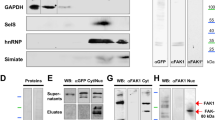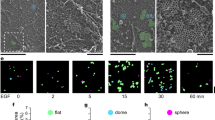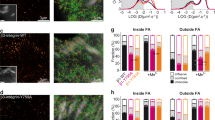Abstract
Integration of signalling pathways initiated by receptor tyrosine kinases and integrins is essential for growth-factor-mediated biological responses. Here we show that co-stimulation of growth-factor receptors and integrins activates the focal-adhesion kinase (FAK) family to promote outgrowth of neurites in PC12 and SH-SY5Y cells. Pyk2 and FAK associate with adhesion-based complexes that contain epidermal growth factor (EGF) receptors, through their carboxy- and amino-terminal domains. Expression of the C-terminal domain of Pyk2 or of FAK is sufficient to block neurite outgrowth, but not activation of extracellular-signal-regulated kinase (ERK). Moreover, activation and autophosphorylation of Pyk2/FAK, as well as of effectors of their adhesion-targeting domains, such as paxillin, are important for propagation of signals that control neurite formation. Thus, Pyk2/FAK have important functions in signal integration proximal to integrin/growth-factor receptor complexes in neurons.
This is a preview of subscription content, access via your institution
Access options
Subscribe to this journal
Receive 12 print issues and online access
$209.00 per year
only $17.42 per issue
Buy this article
- Purchase on Springer Link
- Instant access to full article PDF
Prices may be subject to local taxes which are calculated during checkout






Similar content being viewed by others
References
Ullrich, A. & Schlessinger, J. Signal transduction by receptors with tyrosine kinase activity. Cell 61, 203–212 (1990).
Heldin, C. H. Dimerization of cell surface receptors in signal transduction. Cell 80, 213–223 (1995).
Assoian, R. K. Anchorage-dependent cell cycle progression. J. Cell Biol. 136, 1–4 (1997).
Renshaw, M. W., Ren, X. D. & Schwartz, M. A. Growth factor activation of MAP kinase requires cell adhesion. EMBO J. 16, 5592–5599 (1997).
Schneller, M., Vuori, K. & Ruoslahti, E. Alphabeta3 integrin associates with activated insulin and PDGFbeta receptors and potentiates the biological activity of PDGF. EMBO J. 16, 5600–5607 (1997).
Eliceiri, B. P., Klemke, R., Stromblad, S. & Cheresh, D. A. Integrin alphabeta3 requirement for sustained mitogen-activated protein kinase activity during angiogenesis. J. Cell Biol. 140, 1255–1263 (1998).
Giancotti, F. G. & Ruoslahti, E. Integrin signaling. Science 285, 1028–1032 (1999).
Clark, E. A. & Brugge, J. S. Integrins and signal transduction pathways: the road taken. Science 268, 233–239 (1995).
Falcioni, R. et al. Alpha 6 beta four and alpha 6 beta one integrins associate with ErbB-2 in human carcinoma cell lines. Exp. Cell Res. 236, 76–85 (1997).
Sundberg, C. & Rubin, K. Stimulation of beta1 integrins on fibroblasts induces PDGF independent tyrosine phosphorylation of PDGF beta-receptors. J. Cell Biol. 132, 741–752 (1996).
Moro, L. et al. Integrins induce activation of EGF receptor: role in MAP kinase induction and adhesion-dependent cell survival. EMBO J. 17, 6622–6632 (1998).
Neet, K. & Hunter, T. Vertebrate non-receptor protein-tyrosine kinase families. Genes Cells 1, 147–169 (1996).
Avraham, H., Park, S., Schinkmann, K. & Avraham, S. RAFTK/Pyk2-mediated cellular signalling. Cell Signal 12, 123–133 (2000).
Hanks, S. K. & Polte, T. R. Signaling through focal adhesion kinase. Bioessays 19, 137–145 (1997).
Li, J., Avraham, H., Rogers, R. A., Raja, S. & Avraham, S. Characterization of RAFTK, a novel focal adhesion kinase, and its integrin-dependent phosphorylation and activation in megakaryocytes. Blood 88, 417–428 (1996).
Astier, A. et al. The related adhesion focal tyrosine kinase is tyrosine-phosphorylated after beta1 -integrin stimulation in B cells and binds to p130 cas. J. Biol. Chem. 272, 228–232 (1997).
Zheng, C. et al. Differential regulation of Pyk2 and focal adhesion kinase (FAK). The C-terminal domain of FAK confers response to cell adhesion. J. Biol. Chem. 273, 2384–2389 (1998).
Schlaepfer, D. D. & Hunter, T. Integrin signalling and tyrosine phosphorylation: just the FAKs? Trends Cell Biol. 8, 151–157 (1998).
Lev, S. et al. Protein tyrosine kinase PYK2 involved in Ca2+-induced regulation of ion channel and MAP kinase functions. Nature 376, 737–745 (1995).
Dikic, I., Tokiwa, G., Lev, S., Courtneidge, S. A. & Schlessinger, J. A role for Pyk2 and Src in linking G-protein-coupled receptors with MAP kinase activation. Nature 383, 547–550 (1996).
Lakkakorpi, P. T. et al. Stable association of PYK2 and p130 (Cas) in osteoclasts and their co-localization in the sealing zone. J. Biol. Chem. 274, 4900–4907 (1999).
Schaller, M. D. & Parsons, J. T. Focal adhesion kinase and associated proteins. Curr. Opin. Cell Biol. 6, 705–710 (1994).
Girault, J. A., Costa, A., Derkinderen, P., Studler, J. M. & Toutant, M. FAK and PYK2/CAKbeta in the nervous system: a link between neuronal activity, plasticity and survival? Trends Neurosci. 22, 257–263 (1999).
Ohba, T., Ishino, M., Aoto, H. & Sasaki, T. Interaction of two proline-rich sequences of cell adhesion kinase beta with SH3 domains of p130 Cas -related proteins and a GTPase-activating protein, Graf. Biochem. J. 330, 1249–1254 (1998).
Ueki, K. et al. Integrin-mediated signal transduction in cells lacking focal adhesion kinase p125 FAK. FEBS Lett. 432, 197–201 (1998).
Sieg, D. J. et al. Pyk2 and Src-family protein-tyrosine kinases compensate for the loss of FAK in fibronectin-stimulated signaling events but Pyk2 does not fully function to enhance FAK-cell migration. EMBO J. 17, 5933–5947 (1998).
Marshall, C. J. Specificity of receptor tyrosine kinase signaling: transient versus sustained extracellular signal-regulated kinase activation. Cell 80, 179–185 (1995).
Lavenius, E., Parrow, V., Nanberg, E. & Pahlman, S. Basic FGF and IGF-I promote differentiation of human SH-SY5Y neuroblastoma cells in culture. Growth Factors 10, 29–39 (1994).
Fujii, D. K., Massoglia, S. L., Savion, N. & Gospodarowicz, D. Neurite outgrowth and protein synthesis by PC12 cells as a function of substratum and nerve growth factor. J. Neurosci. 2, 1157–1175 (1982).
Tomaselli, K. J. et al. A neuronal cell line (PC12) expresses two beta1-class integrins — alpha one beta 1 and alpha three beta 1 — that recognize different neurite outgrowth-promoting domains in laminin. Neuron 5, 651–662 (1990).
Traverse, S., Gomez, N., Paterson, H., Marshall, C. & Cohen, P. Sustained activation of the mitogen-activated protein (MAP) kinase cascade may be required for differentiation of PC12 cells. Comparison of the effects of nerve growth factor and epidermal growth factor. Biochem. J. 288, 351–355 (1992).
Traverse, S. et al. EGF triggers neuronal differentiation of PC12 cells that overexpress the EGF receptor. Curr. Biol. 4, 694–701 (1994).
Dikic, I., Schlessinger, J. & Lax, I. PC12 cells overexpressing the insulin receptor undergo insulin-dependent neuronal differentiation. Curr. Biol. 4, 702–708 (1994).
Rankin, S., Hooshmand-Rad, R., Claesson-Welsh, L. & Rozengurt, E. Requirement for phosphatidylinositol 3′-kinase activity in platelet-derived growth factor-stimulated tyrosine phosphorylation of p125 focal adhesion kinase and paxillin. J. Biol. Chem. 271, 7829–7834 (1996).
Leventhal, P. S., Shelden, E. A., Kim, B. & Feldman, E. L. Tyrosine phosphorylation of paxillin and focal adhesion kinase during insulin-like growth factor-I-stimulated lamellipodial advance. J. Biol. Chem. 272, 5214–5218 (1997).
Schlaepfer, D. D., Jones, K. C. & Hunter, T. Multiple Grb2-mediated integrin-stimulated signaling pathways to ERK2/mitogen-activated protein kinase: summation of both c-Src- and focal adhesion kinase-initiated tyrosine phosphorylation events. Mol. Cell Biol. 18, 2571–2585 (1998).
Tokiwa, G., Dikic, I., Lev, S. & Schlessinger, J. Activation of Pyk2 by stress signals and coupling with JNK signaling pathway. Science 273, 792–794 (1996).
Blaukat, A. et al. Adaptor proteins Grb2 and Crk couple Pyk2 with activation of specific mitogen-activated protein kinase cascades. J. Biol. Chem. 274, 14893–14901 (1999).
Dolfi, F. et al. The adaptor protein Crk connects multiple cellular stimuli to the JNK signaling pathway. Proc. Natl Acad. Sci. USA 95, 15394–15399 (1998).
Turner, C. E. Paxillin: a cytoskeletal target for tyrosine kinases. Bioessays 16, 47–52 (1994).
Turner, C. E. et al. Paxillin LD4 motif binds PAK and PIX through a novel 95-kD ankyrin repeat, ARF-GAP protein: a role in cytoskeletal remodeling. J. Cell Biol. 145, 851–863 (1999).
Petit, V. et al. Phosphorylation of tyrosine residues 31 and 118 on paxillin regulates cell migration through an association with CRK in NBT-II cells. J. Cell Biol. 148, 957–970 (2000).
Sieg, D. J. et al. FAK integrates growth-factor and integrin signals to promote cell migration. Nature Cell Biol. 2, 249–256 (2000).
Girault, J. A., Labesse, G., Mornon, J. P. & Callebaut, I. The N-termini of FAK and JAKs contain divergent band 4.1 domains. Trends Biochem. Sci. 24, 54–57 (1999).
Astier, A. et al. The related adhesion focal tyrosine kinase differentially phosphorylates p130 Cas and the Cas-like protein, p105 HEF1. J. Biol. Chem. 272, 19719–19724 (1997).
Menegon, A. et al. FAK+ and PYK2/CAKbeta, two related tyrosine kinases highly expressed in the central nervous system: similarities and differences in the expression pattern. Eur. J. Neurosci. 11, 3777–3788 (1999).
Reiske, H. R. et al. Requirement of phosphatidylinositol 3-kinase in focal adhesion kinase- promoted cell migration. J. Biol. Chem. 274, 12361–12366 (1999).
Daniels, R. H., Hall, P. S. & Bokoch, G. E. Membrane targeting of p21 -activated kinase one (PAK1) induces neurite outgrowth from PC12 cells. EMBO J. 17, 754–764 (1998).
Obermeier, A. et al. PAK promotes morphological changes by acting upstream of Rac. EMBO J. 17, 4328–4339 (1998).
Fagerstrom, S., Pahlman, S. & Nanberg, E. Protein kinase C-dependent tyrosine phosphorylation of p130 cas in differentiating neuroblastoma cells. J. Biol. Chem. 273, 2336–2343 (1998).
Acknowledgements
We thank L. Claesson-Welsh, F. Giancotti, T. Hunter, E. Nånberg, L. Rönnstrand, D. Schlaepfer, J. Schlessinger, S. Thomas, K. Vuori and A. Yoshimura for reagents. We also thank L. Claesson-Welsh and J. Dixelius for help with immunofluorescence microscopy. We are grateful to C-H. Heldin, L. Claesson-Welsh and A. Moustakas for comments on the manuscript. A.B. was supported by a postdoctoral fellowship from the Deutsche Forschungsgemeinschaft (DFG) and I.D. is a Boehringer Ingelheim Fonds Research Fellow.
Author information
Authors and Affiliations
Corresponding author
Rights and permissions
About this article
Cite this article
Ivankovic-Dikic, I., Grönroos, E., Blaukat, A. et al. Pyk2 and FAK regulate neurite outgrowth induced by growth factors and integrins. Nat Cell Biol 2, 574–581 (2000). https://doi.org/10.1038/35023515
Received:
Revised:
Accepted:
Published:
Issue Date:
DOI: https://doi.org/10.1038/35023515
This article is cited by
-
Simiate and the focal adhesion kinase FAK1 cooperate in the regulation of dendritogenesis
Scientific Reports (2022)
-
Phosphorylation of Focal Adhesion Kinase at Y925: Role in Glia-Dependent and Independent Migration through Regulating Cofilin and N-Cadherin
Molecular Neurobiology (2022)
-
A Novel Splicing Mutation c.335–1 G > A in the Cardiac Transcription Factor NKX2-5 Leads to Familial Atrial Septal Defect Through miR-19 and PYK2
Stem Cell Reviews and Reports (2022)
-
Using High-Throughput Animal or Cell-Based Models to Functionally Characterize GWAS Signals
Current Genetic Medicine Reports (2018)
-
Conversion of nanoscale topographical information of cluster-assembled zirconia surfaces into mechanotransductive events promotes neuronal differentiation
Journal of Nanobiotechnology (2016)



